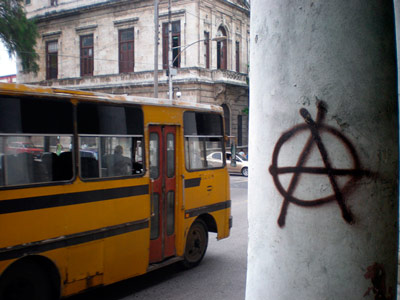Havana Street Art and Graffiti
Isbel Diaz Torres

HAVANA TIMES — In this post, I want to continue to document the street art and graffiti that today decorates the walls, building facades and doors of Havana. The courage and originality shown by some of these public interventions are truly praiseworthy.
Though the government’s “soft censorship” is alive and well and reminds us who the walls belong to, young people in the capital show no signs of letting up and insist on inscribing their opinions on any available surface they can get to.
A number of these epigrams, like Lennon and McCartney’s “Let it Be”, painted in white on the dark blue of the bus stop in front of the Coppelia ice cream parlor, or the word “green”, painted on the wall of a collapsed building, have ostensible poetic and literary connotations.
The word “liberta” (“freedom”), without the last “d”, spray-painted over a white column in front of Havana’s Capitolio building, was one of my most recent discoveries.

A good many spray-painted slogans make different explicit demands or criticisms which continue to be unthinkable for most of the island’s weak-spirited population: “Cuban Workers’ Federation: traitors!”, “Speak Up!”, “How long will we put up with this?”, “Legalize it!”, “Long Live a Free Cuba?” and others.
It appears to me that Cuba’s graffiti artists have moved from the use of euphemisms and flowery prose (common in Cuban street art some years ago) to more confrontational and direct postures, having identified their respective demands more clearly.
In many cases, however, they have chosen to express these demands in English. A means of camouflage, or a way of expressing an iconoclastic perception of our “restricted” Cuban identity, perhaps?
The broad-ranging political postures go from a libertarian anarchist “A”, painted on one of the columns of Havana’s Higher Institute for Design (ISDI) to a swastika (a symbol associated to the Nazi party) in the peripheral neighborhood of La Timba.

In this case, the inscription is painted green (not black, like the Nazi swastica), and we should bear in mind that, for hundreds of millions of people living in non-Western countries, the symbol is associated to concepts and practices totally foreign to fascism.
I must confess, nevertheless, that it was a bit disagreeable for me to run into such a pictogram in a humble neighborhood, populated mostly by people of African descent.
Of course, it would be impossible to discuss the limits of freedom of expression, the use of public spaces, art, democracy, violence or civic responsibilities in the restricted space of this post.
The photographs are merely a testimony of what one comes across in Havana today.
In his books, Uruguayan author and journalist Eduardo Galeano reproduces the texts written on walls of different Latin American cities, texts loaded with poetic, political and ethical content. Some of the Cuban epigrams captured here could well be included among them.
Click on the thumbnails below to view all the photos in this gallery. On your PC or laptop, you can use the directional arrows on the keyboard to move within the gallery. On cell phones use the keys on the screen.






















@bf38ab01ee645d883eeb51ff08715572:disqus Tu no sabes nada de arte y menos de graffiti
Graffiti artists is a misnomer. This is not art. It is vandalism, period. If you want to protest, do it up front, not run away in the night. This is another instance of copying the degradation of the West. Why not invite Banksy to Habana?